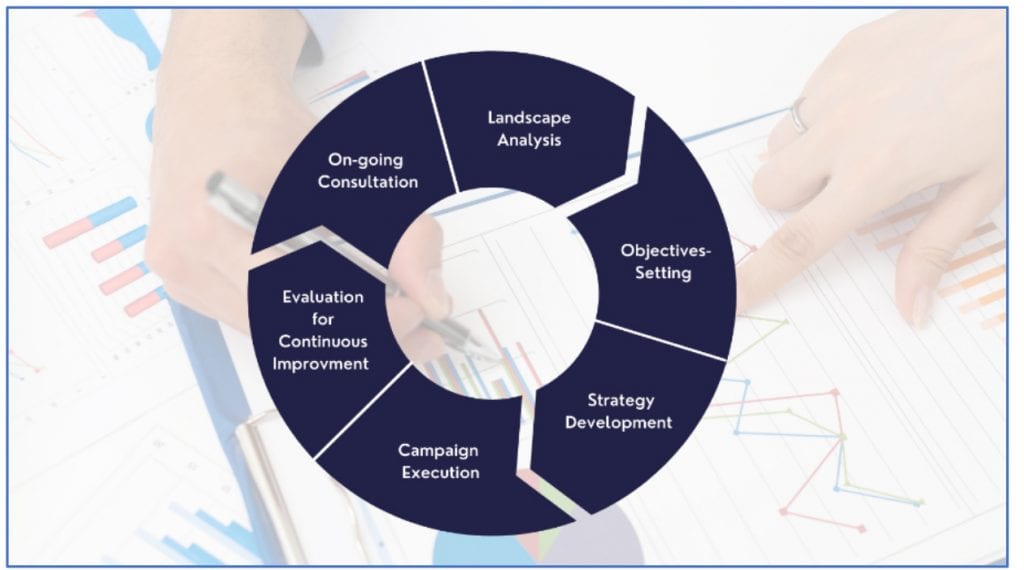
For those interested in approaching PR as a research-and-reality-informed process, there is a simple framework: ‘the Public Relations continuum.’ In the fast-paced omni-channel world of modern PR, this fact-based philosophy provides a blueprint for success. The six-step cycle drives continual improvement, versus objectives and against competitors, to provide opportunities for refinement with every rotation.
Research drives the progression. The two most-common reasons communicators invest in PR research is to: 1) demonstrate the value of PR and 2) generate a positive return on investment (ROI). A research-based progression, the PR Continuum satisfies both.
The amount of data available, some of it free, makes this process more accessible than ever.

Source: The author
Landscape Analysis
The process begins with The Landscape Analysis, which applies research to assess your operating environment, internally and externally. This formative step enables ‘clean-slate PR,’ which makes no assumptions about objectives, strategies, tactics or outcomes. The approach fosters a fresh start for assessing the priorities of the organization and the audiences with whom you communicate.
Landscape Analysis also takes an objective view of past performance, competitors and society to determine the degree to which PR can advance the organization’s priorities.
Setting Objectives
To advance the enterprise, communicators must understand the organization’s aims to help achieve its business objectives. While each component of the research-based PR Continuum is integral to achieving positive results, the initial stage of objectives-setting is critical (it’s also frequently overlooked).
Setting objectives is the foundation for the entire PR program on which strategy, execution and evaluation are formed. What’s more, setting and then beating objectives that are meaningful, reasonable and measurable supports the communicator’s ability to demonstrate the value of PR and drive ROI.
Strategy
The cycle continues with strategy development, which involves interpretation of research to identify a variety of internal and external stakeholders. Once specified, strategy development focuses on the messages that these audiences find credible and compelling when coming from your organization.
The result is stakeholder-centric communication that lays the groundwork for purposeful strategy and tactics.
Strategies–unlike tactics–remain over time and must support a variety of tactical bursts of activity to drive results. As such, research helps inform the messaging and targeting approaches most likely to survive short-term market shifts to deliver positive, sustainable results.
Campaign Execution
Strategy ignites campaign execution. In shorter bursts of action, these tactics deliver strategic messages to the stakeholders most likely to respond affirmatively. Research informs campaigns by identifying the channels–traditional and social media sources, spokespeople, influencers, events, partners, causes and more–through which messages can be delivered to the target stakeholders in ways that are motivating, engaging and trustworthy.
Tactical research is time-based and should be updated regularly to identify which communications vehicles offer the greatest likelihood for success at a given moment. Just as important, tactics must reflect strategy and contribute to meeting or beating objectives.
Evaluation and Analysis
After data collection, statistical analysis helps evaluate performance for continuous improvement. Analysis determines what the results mean and how well they reflect success to guide refinement moving forward.
The purpose of evaluation is to optimize rather than to celebrate (sometimes, you can do both!). Rather than a post-mortem scorecard, we must seek real-time and ‘right-time’ insights to inform and improve as we prepare for the future. It is not the quantity of the data but the quality of the insights and the degree to which the program delivered on its objectives that make research-based evaluation meaningful.
Consultation
As the cycle completes a rotation, we gain opportunities to offer consultation to executives in ways that go beyond PR. Media analysis, one of the most common forms of communication research, offers the unique ability to simultaneously reflect and shape public opinion. PR research, when it includes competitive analysis, provides insight and guidance throughout the enterprise as the organization advances along a fact-based continuum of its own.
Demonstrating Value and Generating ROI
To an earlier point, the desire to demonstrate value and generate ROI motivate most PR pros who invest in communication research. The fact-based continuum helps in both cases:
Very often, demonstrating value begins with the Landscape Analysis. You assess the needs of the organization and prioritize executives’ business goals. Use this input and align with key executives to set objectives that are reasonable, measurable and meaningful. Once they’re approved, you possess the ingredients to overcome executive subjectivity by meeting or beating the objectives you set with them. Continually measuring and refining progress helps communicators improve performance daily. By the time your annual review arrives, you will have had hundreds of opportunities to refine for a positive outcome.
Communication research, analysis and evaluation enable the PR function to properly generate a positive ROI. We do this in three ways:
• Efficiency by doing more with less and for less
• Revenue generation by connecting PR to sales
• Avoiding catastrophic cost by spotting and evading traps before they occur
Some PR practitioners approach communication as an art form, but there’s more to it. In fact, there’s more to art as well. Most art employs an underlying structural foundation. Even improv comedy and improvised jazz solos are based on rules. Rather than inhibiting creativity, these rules focus creativity to where it will generate the best outcome. Similarly, many purely creative PR programs fail to deliver. We need to do something different. And the difference ties directly to fact-based PR.
Contact: [email protected]
